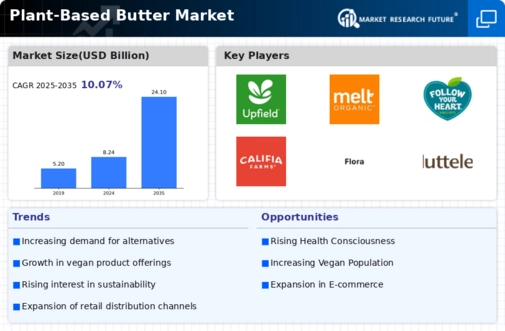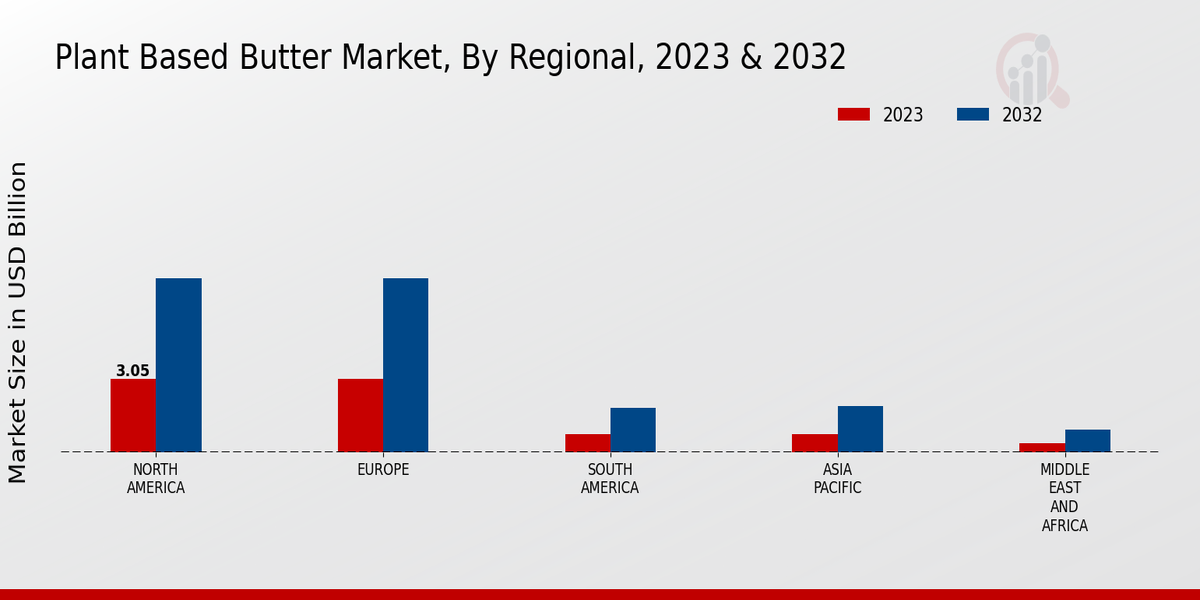Diverse Product Offerings
The Global Plant-Based Butter Market Industry is characterized by an expanding array of product offerings. Manufacturers are innovating to create various flavors and formulations that cater to diverse culinary applications. This diversification not only attracts a broader consumer base but also addresses specific dietary needs, such as lactose intolerance and veganism. As a result, the market is expected to witness a compound annual growth rate (CAGR) of 10.26% from 2025 to 2035. The introduction of unique blends and fortified options enhances the appeal of plant-based butter, positioning it as a versatile ingredient in both cooking and baking.
Market Growth Projections
The Global Plant-Based Butter Market Industry is projected to experience substantial growth over the coming years. With an estimated market value of 8.24 USD Billion in 2024, the industry is on a trajectory to reach 24.1 USD Billion by 2035. This remarkable growth is indicative of a broader shift towards plant-based diets and sustainable food choices. The anticipated compound annual growth rate (CAGR) of 10.26% from 2025 to 2035 underscores the increasing consumer demand for plant-based alternatives. As awareness of health and environmental benefits continues to rise, the market is likely to expand, presenting opportunities for innovation and investment.
Rising Health Consciousness
The Global Plant-Based Butter Market Industry is experiencing a surge in demand driven by increasing health consciousness among consumers. As individuals become more aware of the health implications associated with traditional dairy products, they are gravitating towards plant-based alternatives. This shift is reflected in the projected market value of 8.24 USD Billion in 2024, indicating a robust consumer preference for healthier options. The rise in plant-based diets, often linked to lower cholesterol levels and reduced risk of heart disease, further fuels this trend. Consequently, manufacturers are innovating to create diverse plant-based butter products that cater to health-oriented consumers.
Influence of Social Media and Marketing
The role of social media and targeted marketing strategies significantly impacts the Global Plant-Based Butter Market Industry. Brands leverage platforms like Instagram and TikTok to showcase the versatility and benefits of plant-based butter, thereby reaching a wider audience. Influencer partnerships and engaging content help demystify plant-based products, making them more accessible to consumers. This marketing approach is crucial in driving consumer interest and adoption, particularly among younger demographics who prioritize health and sustainability. As awareness grows, the market is poised for continued expansion, supported by effective marketing campaigns that resonate with modern consumer values.
Regulatory Support and Industry Standards
Regulatory support and the establishment of industry standards are vital drivers for the Global Plant-Based Butter Market Industry. Governments are increasingly recognizing the importance of plant-based products in promoting public health and environmental sustainability. This recognition often translates into favorable policies and incentives for manufacturers. Additionally, clear labeling and quality standards enhance consumer trust in plant-based butter products. As regulatory frameworks evolve, they are likely to facilitate market growth, ensuring that consumers have access to safe and high-quality plant-based alternatives. This supportive environment may further encourage innovation and investment in the sector.
Sustainability and Environmental Concerns
Sustainability plays a pivotal role in shaping the Global Plant-Based Butter Market Industry. As environmental awareness grows, consumers are increasingly opting for products that have a lower carbon footprint. Plant-based butter, derived from ingredients such as nuts, seeds, and oils, typically requires fewer resources than dairy butter, making it a more sustainable choice. This trend is likely to contribute to the market's expansion, with projections indicating a growth to 24.1 USD Billion by 2035. Companies are responding by emphasizing eco-friendly practices in their production processes, thereby appealing to environmentally conscious consumers who prioritize sustainability in their purchasing decisions.


























